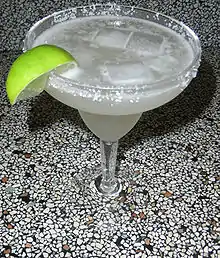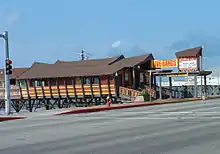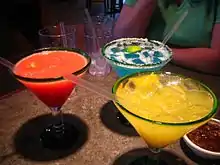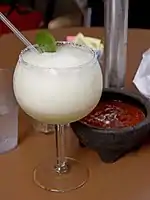Margarita
A margarita is a cocktail consisting of tequila, orange liqueur, and lime juice often served with salt on the rim of the glass. The drink is served shaken with ice (on the rocks), blended with ice (frozen margarita), or without ice (straight up). Although it has become acceptable to serve a margarita in a wide variety of glass types, ranging from cocktail and wine glasses to pint glasses and even large schooners, the drink is traditionally served in the eponymous margarita glass, a stepped-diameter variant of a cocktail glass or champagne coupe.
| IBA official cocktail | |
|---|---|
 | |
| Type | Cocktail |
| Primary alcohol by volume | |
| Served | On the rocks; poured over ice |
| Standard garnish | Salt on the rim (optional) |
| Standard drinkware | .svg.png.webp) |
| IBA specified ingredients |
|
| Preparation | Pour all ingredients into shaker with ice. Shake well and strain into cocktail glass rimmed with salt. |
Origin
According to cocktail historian David Wondrich, the margarita is related to a popular Mexican drink, the Daisy (margarita is Spanish for "daisy"), remade with tequila instead of brandy. (Daisies are a family of cocktails that include a base spirit, liqueur, and citrus. A sidecar and gin daisy are other related drinks.) It became popular during Prohibition as U.S. residents travelled to Mexico for alcohol. There is an account from 1936 of Iowa newspaper editor James Graham finding such a cocktail in Tijuana, years before any of the other margarita "creation myths".[1]
1937 Cafe Royal Cocktail Book contains a recipe for a Picador using the same concentrations of tequila, triple sec and lime juice as a margarita.[2] One of the earliest stories is of the margarita being invented in 1938 by Carlos "Danny" Herrera at his restaurant Rancho La Gloria, halfway between Tijuana and Rosarito, Baja California, created for customer and former Ziegfeld dancer Marjorie King, who was allergic to many spirits, but not to tequila.[3][4] This story was related by Herrera and also by bartender Albert Hernandez, acknowledged for popularizing a margarita in San Diego after 1947, at the La Plaza restaurant in La Jolla.[5]
There are also claims that the margarita was first mixed in Juárez, Chihuahua at Tommy's Place Bar on July 4, 1942 by Francisco "Pancho" Morales. Morales later left bartending in Mexico to become a US citizen, where he worked as a milkman for 25 years. Mexico's official news agency Notimex and many experts have said Morales has the strongest claim to having invented the margarita.[6]
Others say the inventor was Dallas socialite Margarita Sames, when she concocted the drink for her guests at her Acapulco, Guerrero vacation home in 1948. Tommy Hilton reportedly attended, bringing the drink back to the Hilton chain of hotels. However, Jose Cuervo was already running ad campaigns for the margarita three years earlier, in 1945, with the slogan, "Margarita: It's more than a girl's name." According to Jose Cuervo, the cocktail was invented in 1938 by a bartender in honor of Mexican showgirl Rita de la Rosa.[7][8]

Another common origin tale begins the cocktail's history at the legendary Balinese Room in Galveston, Texas where, in 1948, head bartender Santos Cruz created the margarita for singer Peggy (Margaret) Lee. He supposedly named it after the Spanish version of her name, Margarita.[9]
The first known publication of a margarita recipe was in the December 1953 issue of Esquire, with a recipe calling for an ounce of tequila, a dash of triple sec and the juice of half a lime or lemon. A recipe for a tequila-based cocktail first appeared in the 1930 book My New Cocktail Book by G. F. Steele. Without noting a specific recipe or inventor, a drink called the Tequila Daisy was mentioned in the Syracuse Herald as early as 1936. Margarita is Spanish for Daisy, which is a nickname for Margaret.[10]
A later, certainly false, story is that the margarita was invented in October 1961, at a party in Houston, Texas, by party goer Robert James "Rusty" Thomson while acting as bartender. He concocted a mixture of equal parts tequila, Controy orange liqueur, lime, and crushed ice in a salt-rimmed glass.[11][12][13] However, Thomson's recipe was made with Damiana Liqueur, not Cointreau orange liqueur. It is said that the idea was an experiment after running out of rum while making frozen daiquiris.
Variations

The IBA (IBA Official list of Cocktails) standard is 10:4:3, that is tequila:triple sec:fresh lime juice.[14]
The "Original Margarita" recipe as given by Cointreau on their website has slightly more of their own sweet liqueur: 1 part white tequila, 1⁄2 part Cointreau, and 1⁄2 part fresh squeezed lime juice.[15]
Flavored tequila
Apple-cinnamon tequila, triple sec, cranberry juice, fresh lime juice, and an apple wedge or lemon twist for garnish combine to form the Cranberry Margarita With Apple-Cinnamon Tequila, a fall seasonal drink.[16]
Flavored liqueurs
Besides Cointreau, other orange-flavored liqueurs that might be used include Grand Marnier (yielding the "Cadillac Margarita"), Gran Gala, other brands of triple sec, or blue curaçao (yielding the blue margarita). When sweeter fruit juices or freshly puréed fruits are added to the margarita, the orange-flavored liqueur is often reduced or eliminated entirely. In addition to orange-flavored liqueurs, secondary liqueurs may occasionally be added to a cocktail, including melon-flavored or black raspberry-flavored. Other flavors include pineapple and watermelon.
Fresh lime juice
Freshly squeezed lime juice is the key ingredient. The most common lime in the United States is the thick-skinned Persian lime. However, margaritas in Mexico are generally made with Mexican limes (Key limes). These are small, thin-skinned limes and have more tart and an often bitter flavor compared to Persian limes.[17][18]
Frozen margarita
The frozen margarita is a margarita served as an ice slush, similar to other tropical-inspired frozen mixed drinks like the hurricane or piña colada. The ingredients can be processed with ice in a kitchen blender, or for larger output, a slush or soft-serve ice cream machine is used: a cooled, horizontal cylinder has a rotating impeller which churns the mix so it will not freeze solid, and the thick half-frozen slush is dispensed from a spout. Frozen margaritas were first served in La Jolla, when Albert Hernandez Sr. stopped using crushed ice and instead combined the ingredients in a blender in 1947.[5][19] The dedicated frozen margarita machine was introduced by Mariano Martinez in Dallas in 1971.[20]
A lemonade or limeade[21] margarita can be quickly whipped up by using frozen lemonade or limeade concentrate in place of lime juice.[22]
Fruit sodas and sports drinks
Fruity sodas such as fruit punch, lime, pineapple, or mandarin orange Jarritos, or sports drinks such as blue or orange Gatorade,[23][21] can substitute for triple sec.[24] A margarita made with orange soda and beer is a sunrise beer margarita; if it is made with carbonated fruit punch soda, it is a sunset margarita.[25] The variant that uses grapefruit soda is called a Paloma.
Other fruits and vegetables
Alternate fruits and juice mixtures can also be used in a margarita. Fruits like mango,[26] peach, strawberry,[27] banana, melon, raspberry, or avocado[28] are suitable for creating this drink. Orange juice and pomegranate juice (poured down the inner side of the glass) can make a sunset margarita (so named because the orange is at the top and the red at the bottom).[29] Many recipes call for a splash of orange juice. These days, margarita can be prepared in many different ways. When the word "margarita" is used by itself, it typically refers to the lime or lemon juice margarita, but when other juices are used, the fruits are typically added as adjectives in the name; with lime juice or lemon juice added to give it a characteristic margarita flavor (a wedge of lime is often added to the glass). Other varieties of margarita include fruit margarita, top-shelf margarita and virgin margarita.
Coconut cream, coconut milk,[30] and coconut water[31] can also be added to margaritas, e.g. skinny margaritas that substitute, e.g., pineapple juice for liqueurs.[32]
Margaritas can also be made with vegetables such as carrots,[33] beets,[34] cucumber,[35] and celery.[36]
 A blended margarita
A blended margarita
Beer cocktails
A beermarita (or Coronarita)[37] is a beer cocktail that has a bottle of Corona beer or other light-flavored beer[38] poured upside down into a margarita on the rocks.[39]
Skinny
A skinny margarita is a two-ingredient cocktail that leaves out the liqueur and only has tequila and a hint of Rose's lime juice, shaken over ice and served optionally with salt.[40]
Related drinks
A margarita with vodka substituted for tequila is a kamikaze.
Glass
.jpg.webp)
Margaritas may be served in a variety of glasses, most notably the eponymous margarita glass, a variant of the classic champagne coupe; this is particularly associated with blended fruit margaritas, and the glass is also used for dishes such as guacamole or shrimp cocktails. In formal settings margaritas are often served in a standard cocktail glass, while in informal settings, particularly with ice, margaritas may be served in an old fashioned glass.
Popularity
The margarita cocktail was the "Drink of the Month" in Esquire magazine, December 1953, p. 76:[41]
- 1 ounce tequila
- Dash of triple sec
- Juice of 1⁄2 lime or lemon
- Pour over crushed ice, stir. Rub the rim of a stem glass with rind of lemon or lime, spin in salt—pour, and sip.
It was further popularized by the 1977 song "Margaritaville" by Jimmy Buffett, and in 2004 it was described as "the most popular mixed drink in America".[42]
Another reason that has been given for the margarita's popularity is that it feels more complete than a drink that only has sweet and sour flavors, since it engages a third primary taste, salt.[43]
References
- David Wondrich (5 May 2010). "Behind the Drink: The Margarita". Liquor.com. Retrieved 30 June 2011.
- Difford, Simon (2008). Cocktails: Over 2250 Cocktails. Diffords Guide. p. 276. ISBN 978-0-955-62760-6.
- Michael Stetz (9 July 2006). "I'll Have a Mystery on the Rocks with Salt". San Diego Union-Tribune. Retrieved 30 June 2011.
- Paul Chavez, "Danny Herrera, Inventor of Margarita, Dies at Age 90," Los Angeles Times, May 14, 1992.
- Jack Williams (4 May 2006). "Obituary - Albert Hernandez Sr.; Margarita Pioneer, Restaurateur". San Diego Union-Tribune. Retrieved 30 June 2011.
- "Francisco Morales; Credited With Inventing Margarita," Los Angeles Times, January 8, 1997.
- Lisa Bramen, "The History of the Margarita", Smithsonian, May 5, 2009.
- Stacy Finz, "Mastering the margarita: Tequila aside, even experts can't agree on what goes into the legendary cocktail", San Francisco Chronicle, July 25, 2008.
- Rosenberg Library Museum "Lost Treasure: The Balinese Room" Balinese Room. Archived 2012-04-25 at the Wayback Machine
- "Once upon a time in Mexico" Archived 2014-07-08 at the Wayback Machine, Imbibe, March/April 2010.
- de Mancillas, Gloria (1992). Seminario de Historia de Baja California. Instituto de Investigaciones Historicas UABC.
- Hazard, Ann (1992). Agave Sunsets, Treasured Tales of Baja. Renegade Enterprises, pp 157-160.
- Lieber, Sara (2007). MTV Best of Mexico. Wiley Publishing, Inc., p 349.
- "MARGARITA". International Bartenders Association. Retrieved May 5, 2020.
- "The Original Margarita". Cointreau. Retrieved 17 September 2016.
Al Lucero (25 July 2012). The Great Margarita Book: A Handbook with Recipes. Potter/Ten Speed/Harmony/Rodale. p. 23. ISBN 978-0-307-81626-9. - "Cranberry Margarita With Apple-Cinnamon Tequila". Thespruceeats.com. Retrieved 2020-03-14.
- "Key Limes vs Persian Limes - The Cocktail Novice". 2014-10-29. Retrieved 2016-10-05.
- Times, Los Angeles. "Key lime: Handle with care". latimes.com. Retrieved 2016-10-05.
- Poveda, Michelle (3 May 2012). "Frozen in Time". Pacific San Diego. Retrieved 12 July 2018.
Henderson, Patrick (15 July 2015). "The alcoholic version of the Slurpee". San Diego Reader. Retrieved 12 July 2018. - Franz Lidz, "The Uniquely Texan Origins of the Frozen Margarita", Smithsonian Magazine, July 2018
- "Gatorade Margarita". Food Network.
- "3-Ingredient Lemonade Margaritas". August 9, 2016.
- "UF Gatorade Margarita Recipe". Delish. August 31, 2015.
- "If You Like Jarritos Soda, You'll Love These Margs". Delish. July 23, 2015.
- "Sugar Sunset Margaritas". Buy This Cook That. April 26, 2019.
- "Mango Margarita". Supercall. February 13, 2018.
- "Strawberry Margarita". Supercall. February 13, 2018.
- "Avocado Margarita". Supercall. March 21, 2018.
- Annabelle Breakey. "Sunset Margarita Recipe - Sunset Magazine". Sunset.com. Retrieved 2020-03-14.
- "The Best Coconut Margarita Recipe | foodiecrush.com". February 5, 2015.
- "Coconut Margarita". Thoughtfully Simple. May 4, 2015.
- Martin, Macy Daniela (January 18, 2017). "When Coconut Water Meets a Margarita, You Know Cocktail Magic Is Happening". POPSUGAR Latina.
- NY, Flinders Lane, NY (April 7, 2017). "Spiced Carrot Margarita". Supercall.
- Goldman, Josh (January 29, 2018). "Beets By J". Supercall.
- "Frozen Cucumber Margarita". Supercall. March 21, 2018.
- "Celery Margarita". Supercall. March 21, 2018.
- Extra, Corona. "9 Beer Cocktails You Should Probably Try This Summer". BuzzFeed.
- Day, Rachael Ray Every. "Beer Margaritas". Rachael Ray Every Day.
- "20 Mixed Drinks Made With Beer". DrinkWire.
- Cahn, Lauren. "2-Ingredient Cocktails You'll Want to Memorize".
- Barry Popik. "Texas, The Lone Star State: Margarita (cocktail)". Retrieved 12 August 2006.
- Anthony Dias Blue (18 May 2010). The Complete Book of Spirits: A Guide to Their History, Production, and Enjoyment. HarperCollins. p. 114. ISBN 978-0-06-201281-4.
- Hubbard, Lauren (October 31, 2017). "Everything You Need to Know About Bitters". Town & Country.
External links
| The Wikibook Bartending has a page on the topic of: Margarita |
| Wikimedia Commons has media related to Margarita (cocktail). |